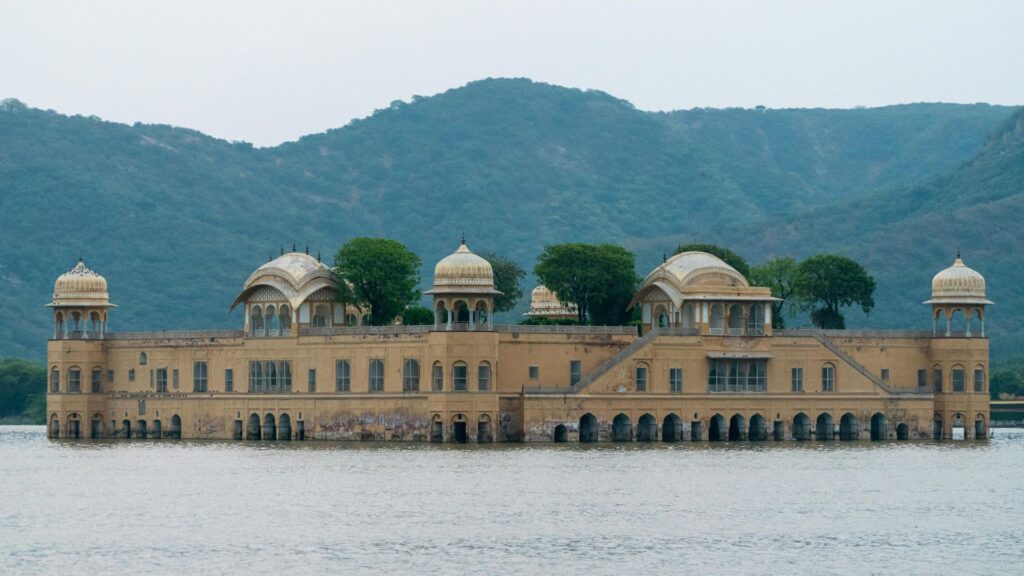
Jal Mahal: The Palace Rising from the Waters of Jaipur"
Nestled amidst the tranquil waters of Man Sagar Lake, Jal Mahal stands as a breathtaking testament to the architectural brilliance and rich history of Jaipur, Rajasthan. Often referred to as the “Water Palace,” this stunning structure rises majestically from the lake, captivating visitors with its unique blend of Mughal and Rajput architectural styles. Originally built as a retreat for the royal family, Jal Mahal is not only an iconic landmark of the Pink City but also a symbol of the region’s cultural heritage. As we delve into the history, architecture, and significance of Jal Mahal, we will explore the myriad ways this enchanting palace continues to inspire awe and admiration among locals and travelers alike.
Introduction to Jal Mahal: A Gem of Jaipur
Nestled serenely in the middle of Man Sagar Lake, Jal Mahal is not just a palace; it’s a mesmerizing sight that seems to float on water. This architectural wonder, with its pink sandstone façade, is a testament to the grandeur of Rajasthan and has captured the imaginations of tourists and locals alike. Whether you’re an avid history buff or just in it for the Instagram shots, Jal Mahal is sure to impress!
Location and Accessibility
Jal Mahal is conveniently located about 6 kilometers from the bustling city center of Jaipur, making it relatively easy to access. You can hop in a rickshaw, hire a cab, or, if you’re feeling adventurous, rent a bicycle to pedal your way there. Just remember: wear sunscreen, because the Rajasthani sun doesn’t mess around!
Overview of Its Unique Features
What sets Jal Mahal apart from your average palace is its unique half-submerged structure, where four of its five floors sit beneath the water’s surface. The palace is surrounded by a serene lake, which not only enhances its beauty but also creates a picturesque setting that changes with the seasons. The blend of nature and architecture here is like something straight out of a fairytale—minus the dragons, of course!
Origins and Construction Timeline
Construction of Jal Mahal began in the 18th century, commissioned by Maharaja Sawai Jai Singh II, the founder of Jaipur. Initially built as a royal lodge for hunting parties, this palace has a history that reflects the rich tapestry of Rajasthani culture. The timeline is a bit blurry, but it’s believed the construction took place between 1699 and 1701, adding an air of mystery to its already enchanting story.
Royal Connections and Usage
Jal Mahal was originally a getaway for the royal family, a place to relax and feast amid nature. Imagine the Maharajas sipping sweet chai while overseeing their hunting exploits—now that’s a royal lifestyle! Over the years, it has been a silent witness to countless royal escapades, making it a cherished part of Jaipur’s history.
Influences of Mughal Architecture
Step inside Jal Mahal, and you’ll find yourself surrounded by the opulent aesthetics of Mughal architecture. The intricately designed arches, elaborate jali work (lattice screens), and lush gardens echo the grandeur of the Mughal era. It’s like stepping into a time capsule where every corner tells a story of artistic prowess and cultural fusion.
Materials and Techniques Used
Constructed primarily from red sandstone, Jal Mahal employs traditional techniques that showcase the craftsmanship of the period. The palace’s design incorporates natural ventilation, which was quite the innovation for its time. And let’s not forget those stunning water features—clearly, the architects knew how to keep things cool during those intense summer months!
Role in Local Folklore and Traditions
Jal Mahal is more than just a pretty face; it’s woven into the local folklore like a golden thread. Stories of love, loss, and the spirits of the lake abound, with each tale adding to its mystique. Locals often share these stories during festivals and gatherings, ensuring that the palace remains a vital part of their cultural identity.
Symbolism in Modern Culture
In today’s context, Jal Mahal symbolizes resilience and beauty, often serving as a backdrop for various cultural events and festivals. It has cemented itself as an icon of Jaipur, inspiring photographers, artists, and travelers alike. With each click of a camera, it finds new life and relevance in the modern world, reminding us that some treasures never fade.
So, whether you visit Jal Mahal for history, architecture, or just to enjoy the view, you’re sure to find a slice of magic in this floating palace of Jaipur!# Jal Mahal: The Palace Rising from the Waters of Jaipur
Best Times to Visit
If you’re planning a trip to Jal Mahal, the best time to pack your bags and head to this serene water palace is between October and March. During these months, Jaipur’s weather is as charming as the palace itself—pleasantly cool! Summer days can be blisteringly hot, making you feel like a roasted jalapeño pepper, while the monsoon can be a tad unpredictable, with the potential for mood-setting rain showers. So, dress comfortably, pack your sunglasses, and get ready to soak in the views (not literally, please).
While the Jal Mahal itself might not be a place for a full tour (it’s more of a view-and-impress location), don’t fret! Jaipur is a treasure trove of nearby attractions. You can stroll along the beautiful Man Sagar Lake, where photographers and Instagrammers unite to snap the perfect shot of the palace reflecting in the water (cue the oohs and aahs). Also, consider checking out the nearby Amer Fort for a touch of history and some Instagram-worthy selfies, or the Nahargarh Fort, which offers breathtaking panoramas of the Pink City. Don’t forget to explore the local bazaars where you can unleash your inner shopaholic!
Current State of Preservation
Jal Mahal’s enchanting beauty is matched only by challenges in preservation. The palace has been undergoing restoration efforts to ensure it remains a majestic sight for future generations. Conservation specialists are working diligently, treating the structure like a delicate rose—carefully, and with lots of love. However, balancing preservation while keeping the site accessible to tourists is like trying to walk a tightrope. The hope is that ongoing efforts will maintain this architectural wonder’s integrity and charm, ensuring it doesn’t slip from our fingers quite like that ice cream cone on a hot day.
Environmental Concerns and Solutions
With great beauty comes great responsibility, and Jal Mahal is no exception. Environmental challenges such as pollution and water quality in Man Sagar Lake threaten both the palace and its surrounding ecosystem. Thankfully, local authorities and environmentalists are stepping up their game, implementing measures like water treatment initiatives and awareness campaigns. They’re trying to ensure that both the lake and palace remain beautiful—after all, nobody wants a palace that’s surrounded by a mucky moat. As they say, a little effort goes a long way!
Depictions in Paintings and Photography
The picturesque Jal Mahal has captured the hearts of countless artists and photographers. Its breathtaking architecture set against shimmering waters has inspired paintings that could make even the most uninspired of us feel a bit poetic. Artists have depicted the palace in various styles, from traditional Rajasthani paintings to modern interpretations. Photographers flock here like moths to a flame, capturing the magic at sunrise and sunset, proving that sometimes, reality can be even more stunning than a filter!
References in Literature and Poetry
Jal Mahal doesn’t just sit pretty in artworks—it’s also made its mark in literature and poetry. The palace has been referenced in various works that depict the rich history and culture of Jaipur, often symbolizing mystique and romance. Poets have spun verses about the tranquil waters and the stories whispered through the ages, giving Jal Mahal an aura of enchanted allure. It’s as if the palace is a muse that inspires creativity, making everyone feel like a Shakespearean bard—minus the need for tights, of course.
Future Prospects for the Palace
As Jal Mahal continues to inspire awe among visitors, its future looks bright! With ongoing conservation efforts, it’s likely to remain a jewel of Jaipur, captivating tourists and locals alike for years to come. There are whispers (or maybe just my imagination) of transforming the surrounding area into a more vibrant cultural hub, blending modernity with tradition. So keep your eyes peeled for exciting developments!
Continued Relevance in Jaipur’s Identity
Jal Mahal is more than just a beautiful structure; it’s woven into the very fabric of Jaipur’s identity. As a symbol of the city’s rich history and architectural prowess, it serves as a reminder of the connection between nature and heritage. Whether you’re a local or a traveler, the palace has a universal appeal—a testament to Jaipur’s charm and a reason to celebrate its ongoing story. So, next time you’re in Jaipur, take a moment to appreciate this stunning palace, rising from the waters, and maybe, just maybe, find a little inspiration yourself!In conclusion, Jal Mahal remains a captivating symbol of Jaipur’s rich heritage and architectural splendor. Its unique location and stunning design continue to draw visitors from around the world, offering a glimpse into the royal history of Rajasthan. As efforts to preserve and promote this remarkable site continue, Jal Mahal’s allure is sure to endure, making it a cherished landmark for generations to come. Whether admired from afar or explored up close, the Water Palace stands as a beautiful reminder of the past and a testament to Jaipur’s cultural identity.
Frequently Asked Questions about Jal Mahal
What is the best time to visit Jal Mahal?
The best time to visit Jal Mahal is during the cooler months from October to March, when the weather is pleasant for sightseeing. Early mornings and late afternoons also provide stunning views of the palace against the backdrop of the rising or setting sun.
Can visitors enter the Jal Mahal Palace?
Currently, Jal Mahal is not open to the public for interior visits, as it is primarily a heritage site. However, visitors can enjoy beautiful views from the surrounding areas and take photographs of the palace from the lakeside.
Are there any activities available near Jal Mahal?
Yes, visitors can enjoy various activities around Man Sagar Lake, including boating, photography, and exploring the nearby gardens. Local vendors also offer souvenirs and refreshments to enhance the visitor experience.
How can I reach Jal Mahal from Jaipur city center?
Jal Mahal is easily accessible from the Jaipur city center, located approximately 4 kilometers away. Visitors can reach the palace by taxi, auto-rickshaw, or by taking a guided tour that includes transportatio

Comments are closed